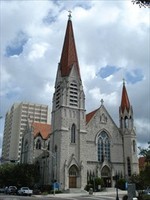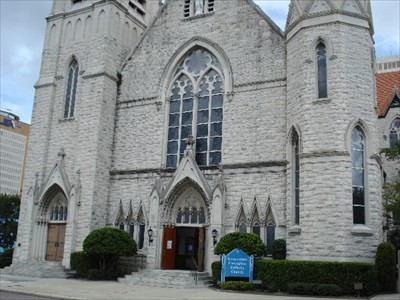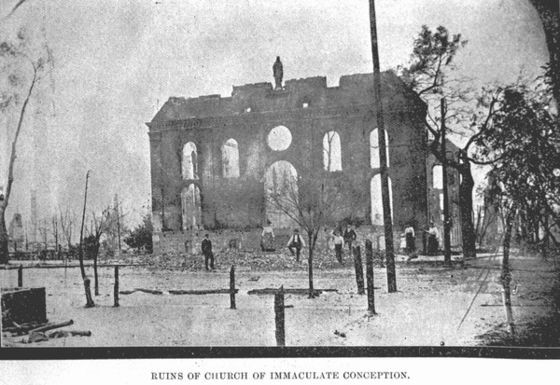Basilica of the Immaculate Conception
Introduction
Text-to-speech Audio
Images
Basilica of the Immaculate Conception

Front of the Basilica of the Immaculate Conception

Ruins of the Church of the Immaculate Conception after the Great Jacksonville Fire of 1901

Backstory and Context
Text-to-speech Audio
The Basilica of the Immaculate Conception originally began as the Church of the Immaculate Conception in 1853, being dedicated in 1854 when the church officially began. In 1829, there were no other Catholic churches in the Jacksonville area, with Catholic families instead gathering in their homes to celebrate mass. Priests traveled by horseback from Georgia to lead the services, organized beginning in 1829 as a mission of the Catholic parish in Savannah to bring Catholicism and churches into Florida. Services lasted that way until 1854, when the Diocese of Savannah sent priest William J. Hamilton to Jacksonville to dedicate a new, small wooden church and become its spiritual leader. That same year, Pope Pius IX declared the Dogma of the Immaculate Conception, making the conception of the Blessed Virgin Mary an Article of Faith. Therefore, it was fitting the church was named in honor of the event.
The wooden church lasted until 1863, when Civil War Union soldiers ransacked and then torched the building, completely burning it to the ground. Members of the church requested they be reimbursed by the U.S. government, but to no avail. In 1868, they established a school under the Sisters of St. Joseph, before the community built a second church in the original’s location to be dedicated in 1871. For 30 years, the second church remained, until the Great Jacksonville Fire of 1901 destroyed most of the city, taking the church with it. Luckily, the Great Fire prompted many architects to travel to Jacksonville in search of work. One of those architects was M.H. Hubbard, who came from Utica, New York. In 1905, he designed a new Church of the Immaculate Conception. Two years later, the Halsema-Woodcock Company laid the foundation, and the building was completed in 1910.
The third construction of the church, which is the oldest Catholic church in Jacksonville and one of the oldest in north Florida, was more magnificent than its prior sisters. At a cost of $160,000, the church two-story church was the tallest building downtown at the time. It was built in a late Gothic Revival style, with a limestone exterior and two towers with carved stone detailed and gold crosses on top. The church contains a bell tower, choir area and balcony, wooden pews, and impressive, full-height, stained glass windows made in Munich, Germany, which depict various biblical scenes. Final additions were made on the building in 1913, marking its completion. In 1979, it was one of few Catholic churches to be “solemnly dedicated,” meaning it cannot be purposefully demolished or used for any reason other than as a church.
The church changed its name from the Church of the Immaculate Conception to the Basilica of the Immaculate Conception in 2013 when it officially received a dedication as a minor basilica. To receive the dedication, a church must be a “center of active and pastoral liturgy with a vibrant Catholic community.” The church’s previous pastor, the late Reverend Antonio Leon, had requested the designation eight years earlier, but the paperwork had been misplaced. However, the Catholic Diocese of St. Augustine Bishop Felipe Estevez renewed the request later on, with Rome’s Congregation for Divine Worship and the Discipline of the Sacraments. Because of the church’s historical, religious, and artistic importance, Pope Francis dedicated the church as one of only 77 Catholic churches in the U.S. and only six in Florida with the dedication of a basilica. The church now operates under that title, serving 800 families. It was placed on the National Register of Historic Places in 1992.
Sources
- National Register of Historic Places Registration Form, National Park Service. November 6th 1992. Accessed September 26th 2020. https://npgallery.nps.gov/GetAsset/0bd0bd39-5987-481d-a0b8-28f6d055fd0f.
- Jacksonville’s Immaculate Conception named a Minor Basilica, The Florida Times-Union. August 15th 2013. Accessed September 26th 2020. https://www.jacksonville.com/article/20130815/NEWS/801248207#:~:text=Immaculate%20Conception%20began%20as%20a,also%20gutted%20the%20second%20church..
- Where people come to encounter God, Basilica of the Immaculate Conception. Accessed September 26th 2020. https://www.icjax.org/.
- Church of the Immaculate Conception - Jacksonville, FL, Waymarking. Accessed September 26th 2020. https://www.waymarking.com/waymarks/wm4JG3_Church_of_the_Immaculate_Conception_Jacksonville_FL.
https://www.waymarking.com/waymarks/wm4JG3_Church_of_the_Immaculate_Conception_Jacksonville_FL
https://www.waymarking.com/waymarks/wm4JG3_Church_of_the_Immaculate_Conception_Jacksonville_FL
Wikipedia
